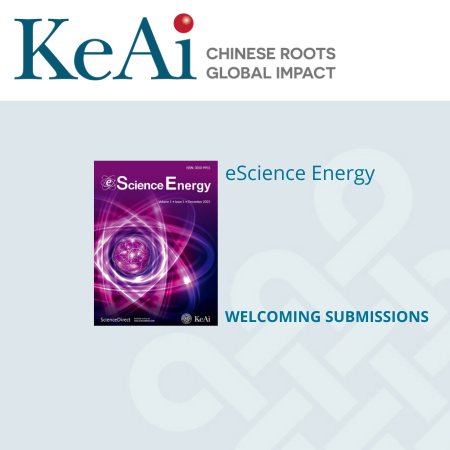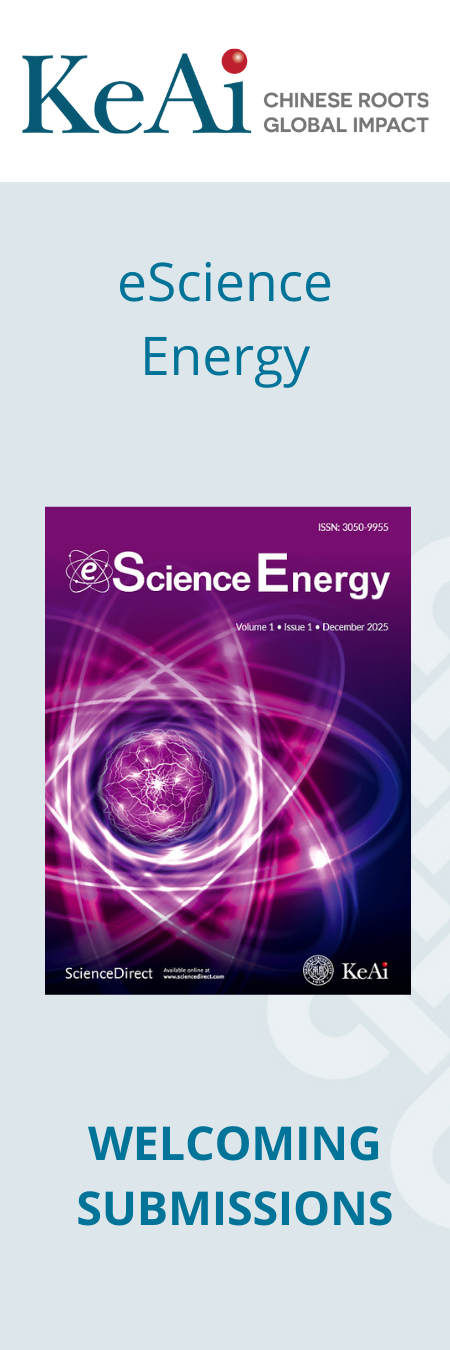Operando studies of lithium–sulfur redox reactions: A review
Available online 12 November 2025
In situ/operando techniques have been foundational for achieving a deep understanding of the complex, multistep Li–S redox reactions to enable the practical application of Li–S batteries. This includes...
Regulating lower hubbard band for tandem electrocatalytic lithium polysulfides conversion
Available online 11 November 2025
Catalytic conversion of lithium polysulfides (LiPSs) is a promising avenue to suppress the shuttle effect and enhance the redox kinetics of lithium–sulfur (Li–S) batteries. However, the consecutive...
Multilayer flexible high-density liquid metal coils based on infusion
Available online 11 November 2025
Given the urgent demand for flexibility in intelligent devices, liquid metals and flexible polymers have emerged as effective materials for the fabrication of flexible coils. However, the majority of...
Electron beam irradiation for spent LiFePO4 recycling
Available online 10 November 2025
Efficient recycling of spent lithium-ion batteries (LIBs) is essential for environmental protection and resource sustainability. Direct recycling offers a promising alternative but suffers from difficulty...
Breaking the symmetry of dual-atom catalysts enables efficient electrocatalytic CO2 reduction over ultra-wide potential window
Available online 10 November 2025
Achieving high-selectivity electrocatalytic CO2 reduction (CO2RR) across a broad potential window is crucial for utilizing intermittent renewable electricity. Herein, we developed a precise synthesis...
Electrophilic fluoroalkyl radical-intermediates enabled organic sulfinate electrolyte additives for sodium-ion supply
Available online 7 November 2025
Na-ion batteries face a critical 10–20% initial capacity loss due to the low initial Coulombic efficiency of hard carbon anodes. While Na-ion supply additives can replenish these losses, their design...
How the curvature-rich structure of N-doped graphene enables asymmetric polysulfide redox catalysis for highly promising Li–S batteries
Available online 4 November 2025
The catalytic conversion of polysulfides remains a critical bottleneck in the development of high-performance lithium–sulfur batteries (LSBs). Despite extensive efforts to engineer carbon-based materials...
Engineering micro-nano structures of SiOC via boron doping-induced self-assembly for superior cyclic stability of lithium-ion batteries
Available online 27 October 2025
Micro-nano structures present significant potential for transformative advancements in secondary battery technology. Through tailoring micro-nano architectures and establishing efficient ion/electron...
Machine learning-driven discovery of high-performance Co/Sr-free air electrodes for protonic ceramic electrolysis cells
Available online 24 October 2025
Protonic ceramic electrolysis cells (PCECs) have emerged as a promising solid-state ion device, attracting considerable attention for efficient hydrogen generation. However, PCECs face multiple constraints,...
Machine-learning guided design of non-precious-metal high-entropy electrocatalysts for alkaline hydrogen evolution
Available online 20 October 2025
High-entropy alloys (HEAs) have emerged as a promising class of electrocatalysts for sustainable hydrogen production driven by renewable electricity, owing to their compositional diversity and flexible...
Implantable magnetoelectric bioelectronics for wireless diagnosis and therapy
Available online 9 October 2025
Real-time, high-fidelity physiological signal acquisition, coupled with targeted in situ interventional regulation, is a prerequisite for intelligent health management. Implantable bioelectronics offers...
Bioinspired triboelectric-driven multisensory framework with autonomous cross-modal adaptation
Available online 9 October 2025
The human multisensory neural network supports advanced cognitive functions through cross-modal integration, recognition, and imagination by synergistically processing visual, tactile, auditory, olfactory,...
Nonequilibrium carriers trigger hydrogen spillover for the highly efficient semihydrogenation of alkynes under ambient conditions
Available online 9 October 2025
Facile reactant dissociation and weakly bound intermediates are essential for achieving both efficient and selective catalysis. However, these two factors are inherently interconnected, making their...
Two-dimensional polymeric metal phthalocyanines with anion fluxing and Li-ion-conducting properties for lithium metal full batteries
Available online 1 October 2025
Herein, we report the molecular engineering of anion-fluxing polymeric metal phthalocyanines (MTPs) by controlling the types of metal centers and incorporating lithiophilic linkers to achieve ultrastable...
A comprehensive review of diffuse reflectance infrared Fourier transform spectroscopy (DRIFTS) techniques in protonic ceramic cells (PCCs): Current status and future perspective
September 2025
Protonic ceramic cells (PCCs) have emerged as a promising technology for power generation, energy storage, and value-added chemical synthesis, offering benefits such as fuel flexibility, low emissions,...
Game changers: scavenging materials for nonaqueous rechargeable battery applications
September 2025
Many potentially harmful reactive species are either present in nonaqueous rechargeable batteries or generated during their operation, with very negative effects on battery performance and/or safety....
Advanced implantable energy storage for powering medical devices
September 2025
Implantable electronic medical devices (IEMDs) are revolutionary advancements in healthcare, enabling continuous health monitoring and disease treatments. To support their further development, IESDs...
Alkaline hydrogen oxidation reaction on nickel-based non-noble metal electrocatalysts
September 2025
The anion exchange membrane fuel cell (AEMFC) enables the use of non-noble metal catalysts, greatly reducing the cost of fuel cells. Nickel-based materials are considered the most promising anode catalysts...
Strategies to maximize the oxygen evolution reaction in layered double hydroxides by electronic defect engineering
September 2025
Layered double hydroxides (LDHs) have emerged as highly promising oxygen evolution reaction (OER) catalysts because of their naturally forming two-dimensional (2D) layer structure and intrinsic oxygen...
Precise Pt-skin manipulation of strain and ligand effects for oxygen reduction
September 2025
Nanostructured platinum (Pt)-skin alloys are promising electrocatalysts for oxygen reduction reaction (ORR) due to their tunable strain and ligand effects which essentially regulate the surface electronic...
Pulsed laser-tuned ruthenium@carbon interface for self-powered hydrogen production via zinc–hydrazine battery coupled hybrid electrolysis
September 2025
Herein, we report the synthesis of selectively face-centered cubic structured ruthenium nanospheres covered in graphitic carbon (denoted as Ru@C) using an effective and innovative pulsed laser ablation...
Li-rich oxide micro-bricks with exposed {010} planes to construct ultrahigh-compaction hierarchical cathodes for Li-ion batteries
September 2025
Although lithium-rich manganese-based (LRM) cathode materials have high capacity (> 250 mAh g−1) due to their multi-electron redox mechanisms and offer cost advantages due to their high Mn content,...
In situ formation of solid electrolyte interphase facilitates anode-free aqueous zinc battery
September 2025
Aqueous Zn batteries (AZBs) suffer from poor Zn anode reversibility. To address this issue, excess Zn foil is often utilized to prolong the cycle life, but it reduces the actual battery energy density....
Bridging graphene for films with superior mechanical and electrical performance for electromagnetic interference shielding
September 2025
Macroscopic films assembled from graphene sheets could be ideal for lightweight and flexible electromagnetic interference shielding applications if the excellent mechanical strength and electrical conductivity...
Adsorption-attraction electrolyte addressing anion-deficient interface for lithium metal batteries
September 2025
Constructing an optimal solid–electrolyte interphase (SEI) through electrolyte strategies is an effective approach to suppress lithium dendrites and improve deposition/stripping reversibility. Specifically,...


